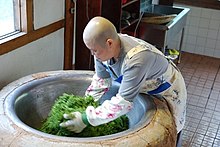Tea processing
| Roasted tea | |||||||||||

A Korean bhikkhuni roasting tea leaves
|
|||||||||||
| Chinese name | |||||||||||
|---|---|---|---|---|---|---|---|---|---|---|---|
| Traditional Chinese | 麩炒茶 | ||||||||||
|
|||||||||||
| Korean name | |||||||||||
| Hangul | 덖음차 / 부초차 | ||||||||||
| Hanja | --茶 / 麩炒茶 | ||||||||||
|
|||||||||||
| Transcriptions | |
|---|---|
| Middle Chinese | |
| Middle Chinese | pʰɨo.t͡ʃʰˠauX.ɖˠa |
| Old Chinese | |
| Zhengzhang | *pʰa.sʰroːʔ.rlaː |
| Transcriptions | |
|---|---|
| Revised Romanization | deokkeum-cha / bucho-cha |
| McCune–Reischauer | tŏkkŭm-ch'a / puch'o-ch'a |
| Steamed tea | |||||||||||

Steaming tea leaves
|
|||||||||||
| Chinese name | |||||||||||
|---|---|---|---|---|---|---|---|---|---|---|---|
| Traditional Chinese | 蒸製茶 | ||||||||||
|
|||||||||||
| Korean name | |||||||||||
| Hangul | 찐차 / 증제차 | ||||||||||
| Hanja | -茶 / 蒸製茶 | ||||||||||
|
|||||||||||
| Transcriptions | |
|---|---|
| Middle Chinese | |
| Middle Chinese | t͡ɕɨŋ.t͡ɕiᴇi.ɖˠa |
| Old Chinese | |
| Zhengzhang | *kljɯŋ.kjeds.rlaː |
| Transcriptions | |
|---|---|
| Revised Romanization | jjincha / jeungje-cha |
| McCune–Reischauer | tchinch'a / chŭngje-ch'a |
Tea processing is the method in which the leaves from the tea plant Camellia sinensis are transformed into the dried leaves for brewing tea.
The categories of tea are distinguished by the processing they undergo. In its most general form, tea processing involves different manners and degree of oxidation of the leaves, stopping the oxidation, forming the tea and drying it.
The innate flavour of the dried tea leaves is determined by the type of cultivar of the tea bush, the quality of the plucked tea leaves, and the manner and quality of the production processing they undergo. After processing, a tea may be blended with other teas or mixed with flavourants to alter the flavour of the final tea.
The history of the tea processing corresponds intimately with the role that tea played in Chinese society and the preferred methods of its consumption in Ancient Chinese society.
Leaf teas are processed either by roasting or steaming. Roasted tea are also called pan-fried tea. Generally, roasted varieties are richer in flavor, while steamed varieties are more vivid in color.
The ancient Chinese society first encountered the tea plant in what is now southern China and processed it as another medicinal herb for use in Chinese herbology. The processing technique used to process fresh tea leaves was to immediately steam the fresh tea leaves and dry them for preservation, which is likely the most ancient Chinese form of tea leaf processing. This processing method was perfected near the end of the Han Dynasty (206 BCE-220 CE) and produced a dried tea that would be classified today as "green tea" and quite similar to modern Japanese sencha. For consumption, dried tea leaves were either decocted with water around with other herbs, or ground into a powder to be taken straight or in a liquid.
With the increase of tea's use in Chinese herbology, production methods changed, where the processed green tea leaves were not immediately dried after steaming. Rather the steamed tea leaves were first pulverized into a paste form, with the paste then formed in moulds and slowly dried into brick tea, a technique well described by Lu Yu in his work The Classic of Tea. Tender leaves and leaf buds were generally not used, as older mature tea leaves were preferred for tea production. Some tea bricks were also produced from mature whole leaves, which typically required the use of a cooked rice slurry (米湯) to bind the tea brick together. The preference of producing tea in brick form possibly stems from the fact that it can be more easily transported and stored.
...
Wikipedia
